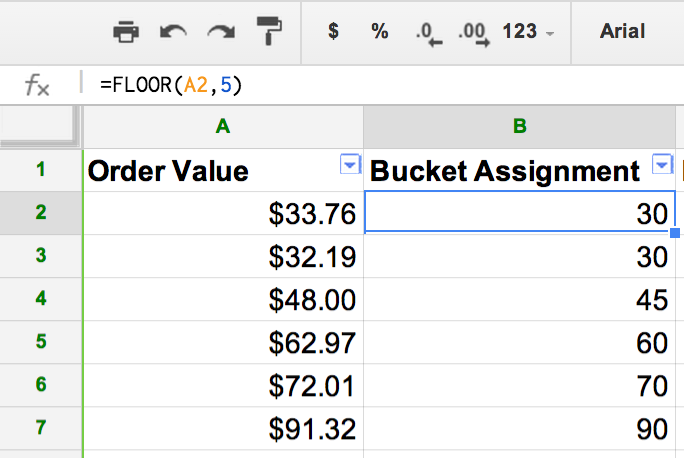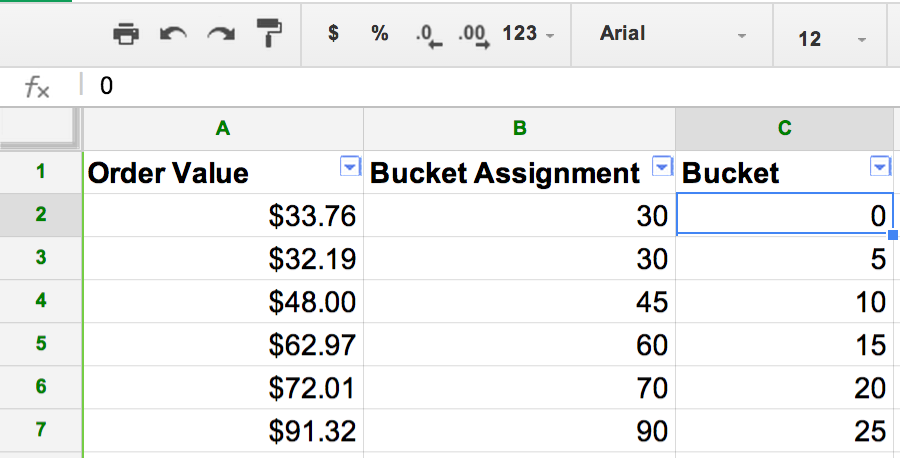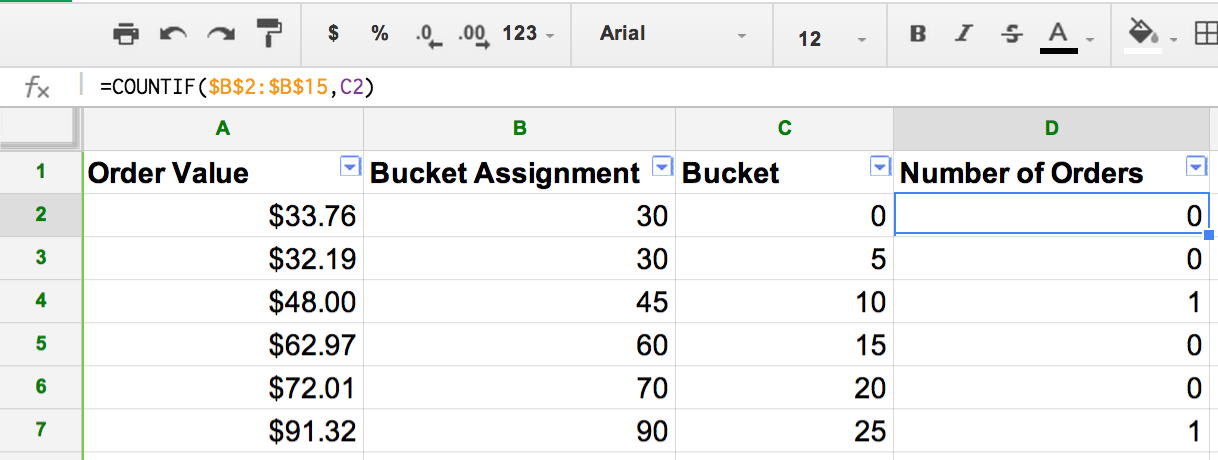Getting your free shipping threshold right is a big deal: 60% of ecommerce companies cite “free shipping with conditions” as their most successful marketing tool. And the reason is simple — free shipping is incredibly effective at boosting average order value. In fact, 3 out of 4 customers admit to adding an extra item or two to their cart to qualify.
Free shipping is a powerful motivator, but it’s also expensive. This makes it imperative to get the balance right. You want to find that sweet spot where customers are motivated to spend a bit more to hit the free shipping threshold, without making it so high that they abandon the purchase completely.
In this post, we will provide a step-by-step, quick-and-dirty guide to help you figure out whether your free shipping threshold is working for you.
Too low, too high, or just right?
Before you dive into your own data, you need a sense of what you’re looking for. You should see something similar to one of the following scenarios.
Problem: Free Shipping Threshold Set Too Low
If your free shipping threshold is set too low, you will see a large number of orders at and beyond your threshold level. Your data may look something like this:
In this case, the threshold falls below the median order value, meaning there is a large number of orders that qualify for free shipping. If your chart looks like this, it means the concept of free shipping as a marketing tool is not really working for you. You are giving it away too cheaply, so a large number of your customers have no motivation to reach for it.
Solution:
Raise your shipping threshold. This is a potentially unpopular move, but one that could have big impact on your bottom line.
Problem: Free Shipping Threshold Set Too High
If you have the opposite problem, and your free shipping threshold is set too high, it means there is a large number of orders that fall below the range where customers will find it advantageous to tack on extra items. When you visualize your data, it might look something like this:
There is a spike at the free shipping threshold, but a significant dip between the highest number of orders and the free shipping threshold. This means your free shipping threshold is so far away from the median order value that customers are not willing to add additional items to reach it. Think about it this way: if your threshold is currently set at $50, and you have a large number of customers making $25 purchases, they generally won’t be willing to double their purchase amount to get free shipping. If the threshold is set at $35 or $40, however, reaching becomes more likely.
If your data looks like this, you should also take a look at your percentage of abandoned shopping carts. A high shipping threshold can backfire by driving customers away.
Solution:
Move your free shipping threshold lower. Making this adjustment correctly can result in a significant increase in order values across the board.
Success: Free Shipping Threshold Set Just Right
If you’re on the right on track, congratulations! Your data visualization will still show a dip between the highest number of orders and the threshold, but it will be a small one. It should look something like this:
The highest number of orders fall below the threshold, but not far below it. In other words, the threshold is set just far enough from the median order value that customers are still willing to add an extra item or two to their carts to qualify for free shipping.
How to look at your data and figure out for yourself
Your data, whether in a spreadsheet or a business intelligence tool like RJMetrics, can help you pinpoint your ideal free shipping threshold with a high degree of accuracy. The idea is to gather data on the number of orders by order value over the past 6 months, and then look at a visual representation of the data. You should see something similar to one of the sample charts above.
Here’s how to do the calculations in a Google Spreadsheet:
- Export order history for the past 6 months to Excel, and create a column of data for “Order Value” (minus shipping costs).
- Come up with a series of buckets ($5-$10, $10-$15, etc) that make sense for your business. Shipping thresholds are usually set in numbers ending in -0 or -5, so make sure you’re setting increments that will be useful for visualizing your data.
- Create a second column called “Bucket Assignments“. The formula for this is =FLOOR (A2, 5). The “5” in this case means that the formula will round the “Order Value” number down to the nearest multiple of 5, determining to which bucket each order should be assigned.
- Next, create a column called “Bucket” with a list of numbers starting at 0 and increasing according to the size buckets you have chosen.
- To determine how many orders fall in each bucket, create a column called “Number of Orders” and use the following formula: =COUNTIF($B$2:$B$15, C2).
- Now it’s time to visualize your data. Create a chart with “Number of Orders” on the y-axis and “Order Value” on the x-axis, showing your buckets.
- Take a look at your chart to see around which values you have the highest number of orders. Is your median order value significantly below your current free shipping threshold? Above it? Which of the above sample charts does your chart most resemble?


Beginner Tip: don’t forget to use the dollar sign ($) in your cell range references, so that the range doesn’t change when copied and pasted.
You should see something like this:

Feel free to use our Google Spreadsheet template to get you started.
Test It
This data will show you if your shipping threshold is too high or too low, but it may be necessary to run a few experiments to refine your threshold. There are a few ways you could do this:
- Test your ideal range of thresholds. Make a change to your free shipping threshold and and run it for a month to see how the numbers compare. Repeat until you have data on a series of thresholds.
- Run free shipping promotions. Try a month-long, sitewide promotion lowering the shipping threshold on all orders.
- A/B test it. Do an A/B test where half your visitors get the free shipping offer, and half don’t. If you want to test out the effects of raising your shipping threshold, you could simply eliminate your current threshold, and do an A/B test where half of your visitors get the higher threshold (as a seeming “promotion”), and others get no threshold.
Changing your shipping threshold is a move that will be immediately felt by your customers, so it is important to be strategic about any experimentation (as in Etsy’s case, it it can be a PR disaster if your customers start to feel like guinea pigs). Whatever you decide, using your data to help guide your decision will put you on the right track.
Advanced Considerations
You now have the skills to evaluate your company’s free shipping threshold. What we’ve covered is enough for a growing ecommerce store to find their ideal shipping threshold, but if you’re an advanced data nerd, you may want to take your analysis to the next level. Here are a few other considerations you may want to take into account:
- Margin analysis. How much is your shipping costing you? If you are selling low-margin items that are costly to ship (due to weight, fragility, need for refrigeration), does it make sense for you to offer free shipping at any level?
- Domestic versus international orders. International shipping is usually costlier than domestic shipping, so it’s much more likely that your shipping threshold might be causing you to lose money on international orders. Try breaking down your data and doing a separate analysis for each.
- Controlling for promotions. To more clearly see the effect of your free shipping threshold over the past 6 months, you’ll want to remove any orders from your data that were affected by promotions like holiday free shipping, limited time offers, coupon codes, and membership programs.
You can continue to fine-tune your free shipping threshold as your company grows, checking in periodically to see if anything has changed.
Ship smarter
So, there it is! If you’re not sure your free shipping threshold is at the right level, it’s time to find out. Free shipping is a powerful, proven marketing tool – but it can also be money down the drain if you rely on guesswork alone. Figuring out your optimal threshold requires minimal effort and can have an immediate positive impact on your business.

